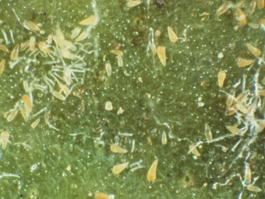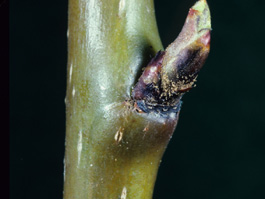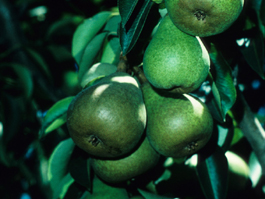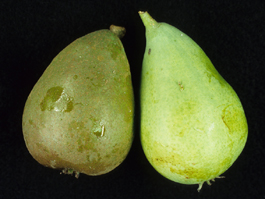by George N. Oldfield, Peter H. Westigard, Michael Smirle, and John Dunley, originally published 1993
Epitrimerus pyri (Nalepa) (Acari: Eriophyidae)
Pear rust mite was probably brought to the United States from Europe in the 19th century with trees or scion cuttings. It is a common pest throughout the Pacific Northwest and can cause serious fruit damage if untreated. While several predators feed on the pear rust mite, none controls it well enough to prevent commercial damage.
Hosts

Pear rust mite is found only on cultivated pear, several Pyrus species, Cydonia sp. (quince) and Pyronia (Cydonia X Pyrus).
Life stages
Egg
See description of apple rust mite.
Immatures
See description of apple rust mite.
Adults
Adults are about 150 microns long and are difficult to see without magnification. A 10- to 20-power lens is recommended. They are broad at the front, tapered at the rear and are yellowish brown. They have only two pairs of legs which are at the front end of the body.
Life history

Pear rust mite overwinters in bark crevices or behind loose bud scales, usually on 2- to 3-year-old wood. Overwintering deutogyne females emerge at bud expansion.
They rapidly invade opening fruit clusters where they feed and lay eggs. The eggs develop into protogynes and males. Between the egg and adult stages, the pear rust mite passes through two nymphal stages. Pear rust mites develop twice as fast as apple rust mites and can develop in slightly cooler temperatures. Numerous generations of the summer form develop each season, and the pest can persist through the growing season if it has enough succulent new foliage on which to feed. A lack of suitable foliage is thought to induce formation of the resting deutogyne female. Dispersal is probably by wind.
Damage
As pear rust mite starts feeding within the developing fruit clusters, it can damage fruit very early in the season. The feeding causes light russeting that can cover the entire surface of the fruit. Often, however, only the calyx end of the fruit is russeted. The russet is most obvious on clear-skinned pears such as Bartlett, Anjou and Comice. Naturally russeted cultivars, such as Bosc, and red-skinned varieties seem more tolerant of rust mite damage. The pear rust mite also feeds on young leaves which, if heavily attacked, turn bronze in color. Heavy feeding can cause defoliation and reduced shoot growth. Although pear rust mite may persist on both fruit and foliage throughout the season, it causes the most severe damage in the early spring. For that reason, direct controls are usually applied prebloom.
Monitoring
Because of its small size, spotty distribution and low injury threshold, it is very difficult to monitor pear rust mite for the purpose of relating population density to potential damage. In most cases, if pear rust mite is detected at all, especially prebloom, it needs to be controlled.
Because pear rust mite can damage fruit early in the season, sampling should begin at the clusterbud stage of tree development. Large numbers of buds may have to be sampled to detect low, but still injurious, levels of infestation. At least 100 clusters per 10-acre block should be examined. These can be selected at the clusterbud through pink-bud stages and should be taken from 3- to 4-year-old wood. The entire fruit cluster should be examined, including fruit buds or fruit, leaves and the younger green, woody tissue at the base of the bud. Those same samples also can be used to gather information on other pests, including spider mites, pear psylla and predaceous mites.
Later in the season, pear rust mite can be monitored using leaf samples taken to monitor pear psylla and spider mite. In addition, packing house records showing the sources of injured fruit and extent of injury are helpful for detecting sites that are at risk.
Biological control
Pear rust mite is attacked by several indigenous predators including predaceous mites, green and brown lacewings, coccinellids and larvae of the cecidomyiid fly Arthrocnodax. However, in the Pacific Northwest, pear rust mite causes severe fruit damage each year where it is left uncontrolled. This suggests that there are insufficient natural controls to make biological control a viable alternative to chemical suppression.
Management
A study on the relationship between rust mite density and russet damage on Bartlett pears showed that it would pay the orchardist to control the mite if more than 1% of the fruit were damaged. It also showed that populations averaging more than 5 mites per fruit would result in more than 1% of the fruit being damaged, i.e., having more than 5% of the surface russeted.
Sulfur compounds are effective when applied prebloom or postharvest and are relatively nondisruptive to the natural control agents important in the suppression of other pear pests.
Materials available for pear
Excerpt from the WSU Crop Protection Guide. For timings at which each pesticide can be used refer to the Crop Protection Guide.


